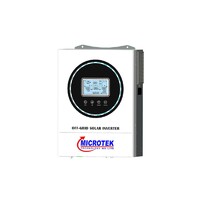What are the classifications and load types of off-grid inverters?
Product Quick Detail
- FOB Price
- USD $40.00 / Piece
- Minimum Order
- 100
- Place Of Origin
- China
- Packaging
- N/A
- Delivery
- 30 days
Specifications
What are the classifications and load types of off-grid inverters?
I. Classification of off-grid inverters
Inverters can be divided into two main categories according to the waveform, one is a pure sine wave inverter and the other is a modified wave inverter.
The rectified sine wave inverter uses PWM pulse width modulation to generate a corrected wave output. Due to the existence of about 20% harmonic distortion, it cannot carry inductive loads such as air conditioners but can carry resistive loads such as lamps.
The rectified sinusoidal inverter uses a non-isolated coupling circuit, which is simple to install and highly efficient. Pure sine inverters use isolated coupling circuit design, which is complex and costly, and can be connected to any common electrical equipment (including TVs, LCDs, etc., and especially inductive loads such as refrigerators) without interference.
Off-grid inverters can be divided into high-frequency machines and industrial-frequency machines according to the degree of isolation.
High-frequency switching components using high-frequency switching technology or high-frequency isolation transformers instead of the industrial-frequency transformers in the inverter are called high-frequency inverters; those with industrial-frequency isolation transformers are called industrial-frequency inverters.
The advantages of the industrial frequency inverter are stable and reliable power components, strong overload capacity and strong shock resistance, the disadvantages are low efficiency, heavyweight and expensive. There are two types of high-frequency inverters, high-frequency isolated and low-frequency isolated. The advantages are small size, high efficiency and low price, the disadvantage is that the shock resistance is slightly lower.
The output power of the inverter needs to be greater than the load power. For demanding applications such as monitoring stations and communication stations, the output power is the sum of all load powers. However, for a typical household, considering that all loads cannot be switched on at the same time, a factor of 0.7-0.9 can be multiplied by the sum of the load powers in order to save costs.
II. Types of loads for off-grid inverters
In PV off-grid systems, the power of the off-grid inverter is usually determined according to the type and power of the customer\'s load. Loads can be divided into resistive loads, inductive loads and capacitive loads.
Resistive loads: Loads with no phase difference in voltage are resistive loads, such as rice cookers, electric bulbs, electric heaters, electric soldering irons, etc.
Capacitive load: the load with phase difference of voltage when the current is ahead is capacitive load, such as compensation capacitor, computer, TV, etc.
Inductive load: When the current lagging voltage is a phase difference, the load is an inductive load, such as a washing machine, air conditioner, refrigerator, water pump, hood and other loads with motor and transformer, relay, compressor, etc.
The starting power of inductive loads such as motors is 5 to 7 times the rated power. When estimating the power of the inverter, the starting power of these loads should be taken into account.
If the load is a lift, for example, it must not be connected directly to the output of the off-grid inverter, because when the lift falls, the motor reverses and a counter-electromotive force is generated, which enters the inverter and can easily damage it. If disconnection is necessary to use the grid system, it is recommended to add an inverter between the inverter and the lift motor.
Now the price of microtek company inverter is reasonable, if you have needs, please contact us.
- Country: China (Mainland)
- Business Type: Trading Company
- Market: Europe,Americas,Africa,Middle East,Asia
- Founded Year: 2010
- Address: 27th floor, Building A, Fortune Plaza, Middle East Third Ring Road, Chaoyang District, Beijing
- Contact: Joanna Wang










